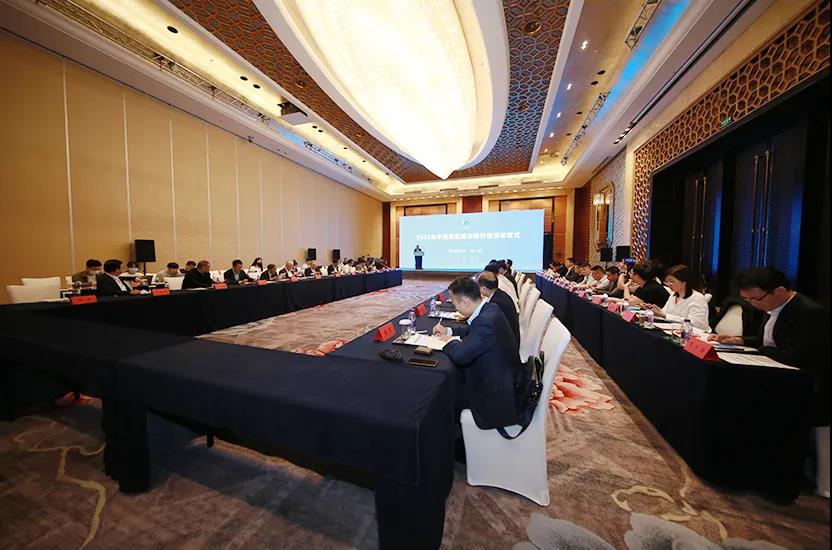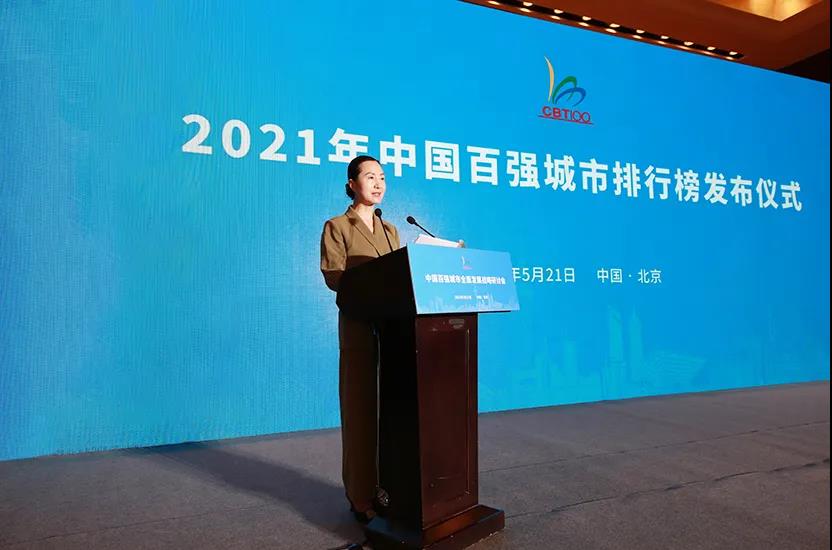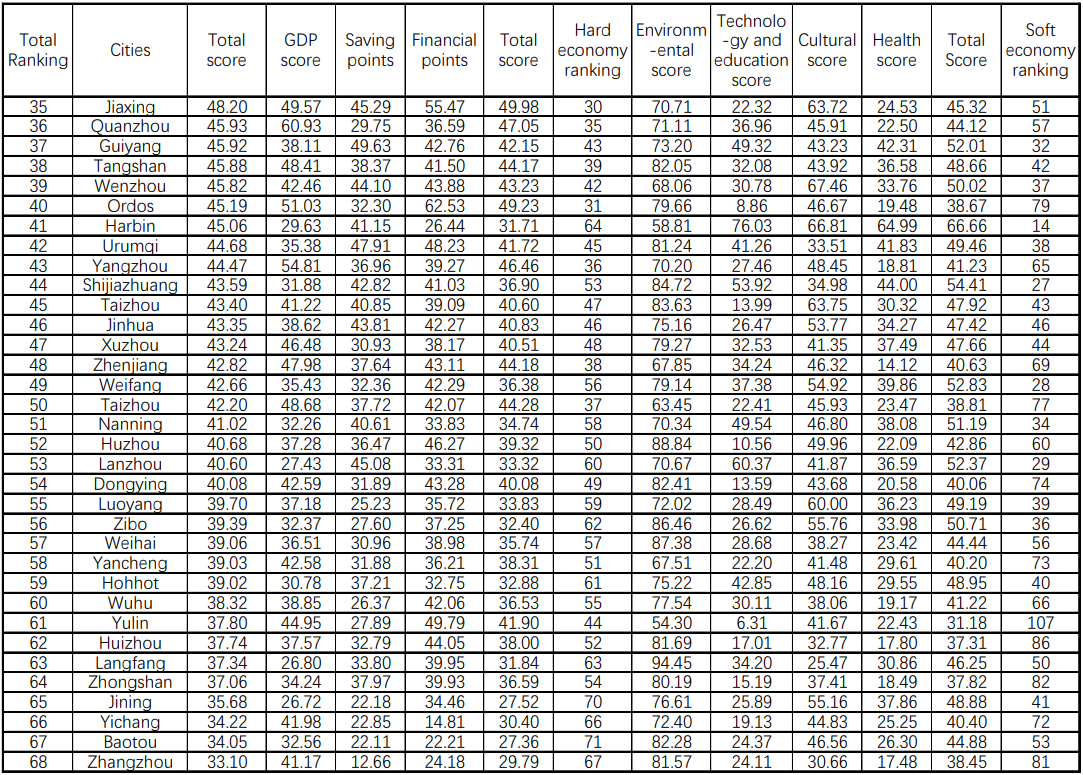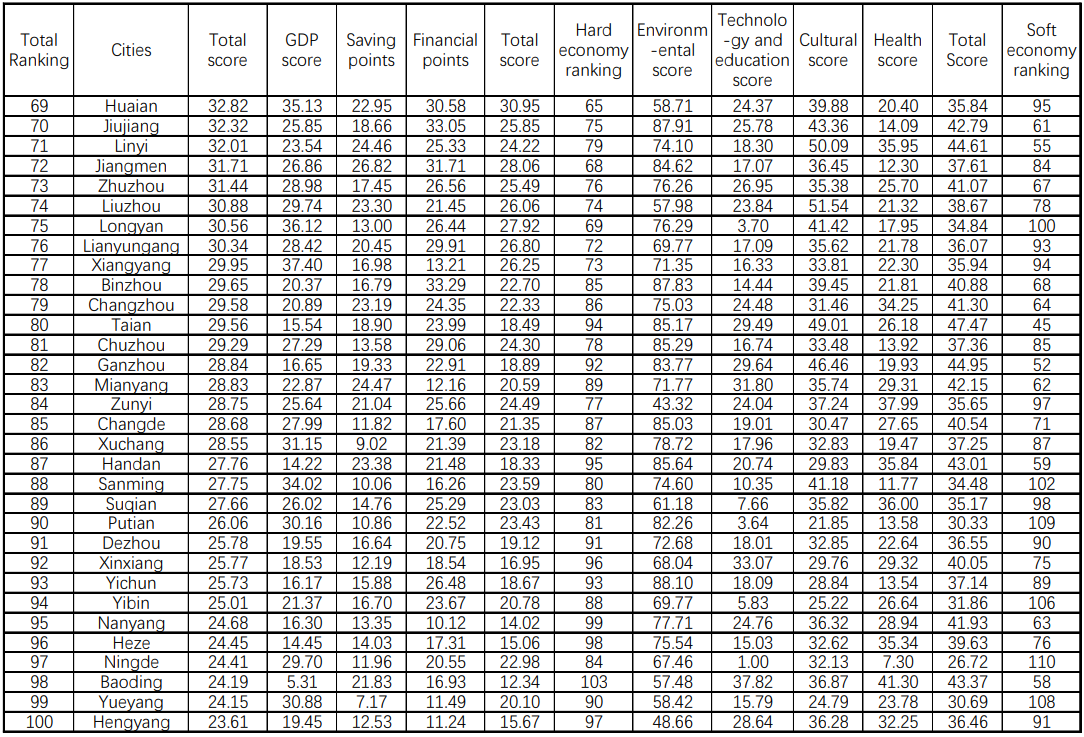Welcome To China Business Top 100 Forum!!
On May 21, the Warton Economic Institute officially released the "2021 CBT 100 Cities Ranking" in Beijing. The WEI has organized the annual "List of CBT 100 Cities Ranking " for seven consecutive years since 2015.

The list takes the top 110 prefecture-level and above cities in terms of total GDP as the annual finalists, and sorts them according to the comprehensive scores of their hard economic indicators (weight 0.618) and soft economic indicators (weight 0.382), and takes the top 100 as the annual ranking. Top 100 cities. Hard economic indicators are composed of GDP, savings and finance, and soft economic indicators are composed of environment, science and education, culture and health. The score of each individual indicator is composed of its total score (weight 0.5) and per capita volume score (weight 0.5).
Determine the annual list of shortlisted cities according to the total GDP index and advocate that cities should continue to grow bigger. The addition of the per capita volume index advocates that cities should continue to become stronger. Considering soft economic indicators, it is advocated that cities should continue to be better, and the “bigger, stronger and better” focus on the orientation and incentives of the "Five Civilization Construction" and "Five Development Concepts", and can more comprehensively and scientifically measure a city's comprehensive development level in terms of economy, society, science and education, culture and ecology.
In the "2021 China Business Top 100 Cities Ranking", Beijing and Shanghai are the top two, with comprehensive scores of 94.72 and 90.31 respectively. The third to tenth places are Shenzhen (82.14), Guangzhou (80.36), Hangzhou (77.27), Nanjing (76.91), Suzhou (74.52), Chengdu (72.23), Wuhan (70.55) and Wuxi (67.40) . This year, Binzhou, Yibin and Ningde were newly added to the top 100 cities, while Jiaozuo, Daqing and Zhanjiang dropped out of the top 100 cities.

The "2021 CBT 100 Cities Ranking" has four features that deserve special attention:
1. The competition for the top ten rankings is fierce, and the future of the three cities in WuXi, Shao Xing and Zhen Jiang can be expected
The ranking of the top ten has changed significantly, with Shenzhen surpassing Guangzhou and ranking third; Nanjing surpassing Suzhou and jumping to sixth place. Wuxi ranks among the top ten in the country for the first time, and its hard economic strength ranks eighth in the country, and its per capita volume index ranks among the top in the country. , the comprehensive strength is expected to continue to advance. Shaoxing successfully entered the national top 30, ranking 29th. In recent years, Shaoxing has vigorously implemented the project of "reinforcing the shortcomings", and its soft economic strength has been greatly improved. It has become one of the model cities for the comprehensive and balanced development of the soft and hard economy, and is firmly seated as the "third city" in Zhejiang. This year, Zhenjiang achieved a historic breakthrough in the ranking, ranking 48th, a significant improvement of 9 places compared to the trough in 2019 (57th), and the momentum of "running up" is obvious. In addition, Lanzhou, Zhuhai, Guiyang, Huai'an, Longyan and other cities all rose sharply.
2. Jiangsu and Fujian’s achievements are dazzling, and Guangdong is polarized
In the inter-provincial pattern, Jiangsu (13), Shandong (13), Guangdong (8), Zhejiang (8) and Fujian (8) ranked the top in the number of cities on the list. All 13 cities in Jiangsu are on the list, and three of them (Nanjing, Suzhou, Wuxi) are in the top ten of the top 100 cities, ranking first among all provinces in terms of their ranking rate and comprehensive strength. In recent years, the number of cities on the list in Fujian has continued to increase, and the ranking rate (88.89%) has ranked second among all provinces. This year, Ningde (97th) is a new top 100 city. The number of cities in Guangdong on the list continued to decrease, from the highest point of 11 to 8, with a list rate of only 38.10%. Guangdong has top star cities such as Shenzhen and Guangzhou, but there are still 13 cities that are not on the list, and the polarization is serious. How to enhance the radiating and leading role of Shenzhen, Guangzhou and other central cities, achieve coordinated economic development within the province, and promote common prosperity is a sharp and important issue for the development of Guangdong in the future.
3. The cities along the Yangtze River Economic Belt occupies half of the list, and Yunnan, Guizhou and Sichuan have made significant progress
In the 2021 China Top 100 Cities List, a total of 44 cities from 11 provinces and cities along the Yangtze River Economic Belt are on the list, accounting for half of the top 100 list. The good news is that the upstream Chengdu-Chongqing urban agglomeration, the mid-stream Wuhan urban agglomeration, and the downstream Yangtze River Delta urban agglomeration are booming, driving the coordinated development of the East, China and the West. In addition, seven cities entered the top ten of the top 100 cities, which is undoubtedly a veritable gold belt on China's economic map. The three provinces of Yunnan, Guizhou and Sichuan have made significant progress, and all six cities on the list have risen in position. It is commendable that Chengdu, which ranks in the top ten, has improved by two places; Guiyang has improved by 12 places, which is one of the cities with the most progress; Yibin is one of the new top 100 cities (94th), Kunming (up 2 places), Mianyang (up 3 places) and Zunyi (up 1 place) also made progress in the three cities. With the continuous advancement of the national strategy for the development of the Yangtze River Economic Belt, the status and role of the Yangtze River Economic Belt in China's economy will be further enhanced. The implementation of national strategies such as the ecological protection and high-quality development of the Yellow River Basin and the Pearl River-Xijiang Economic Belt, which take the basin as the main line, will also drive the comprehensive and coordinated development of the relevant regional economies.
4. The lag of soft economic indicators hinders the comprehensive development of cities
Soft economic strength is an important part of a city's comprehensive strength, and it is also the core element that reflects the city's energy level. Compared with the hard economic indicators, the soft economic indicators of some cities lag significantly, which affects the comprehensive and balanced development of the city. Among them, Yulin (63 places behind in soft economic indicators), Zhuhai (54 places behind in soft economic indicators), Ordos (48 places behind in soft economic indicators), Taizhou (40 places behind in soft economic indicators), and Changzhou (35 places behind in soft economic indicators) , and Huizhou (34th behind in soft economic indicators), the six cities are particularly prominent. These imbalanced cities should focus on the development of the fourth industry with science, education, culture and health as the main body, and the comprehensive development of the fourth industry will drive the improvement of soft economic indicators and the overall strength of the city.



Remarks:
1. "2021 China Business Top 100 Cities List" is designed and compiled by the Warton Economic Institute.
2. This ranking takes prefecture-level and above cities as the statistical objects, and takes the top 110 cities in the total GDP as the shortlisted cities, and calculates according to the scores of their hard economic indicators (weight 0.618) and soft economic indicators (weight 0.382). Based on their comprehensive scores, the "2021 CBT 100 Cities Ranking List" will be launched in this order. The hard economic indicators are composed of GDP, savings and fiscal revenue, and the soft economic indicators are composed of environment, science and education, culture and health. The score of each individual indicator is composed of its total score (weight 0.5) and per capita volume score (weight 0.5).
3. The original data comes from the "China Urban Statistical Yearbook" and related provincial and municipal statistical yearbooks and statistical bulletins.
4. If you have any questions or suggestions, please contact the Warton Economic Institute CBT 100 Cities Research Group (021-64077255; bqcs@cbt100.com).